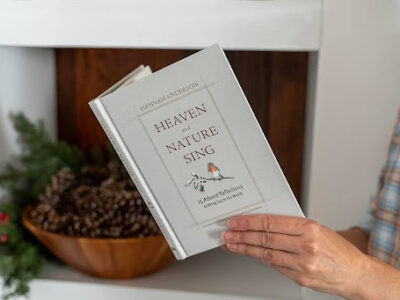I’m not the kind of person who seeks out confrontation. Even the thought of having to defend my position raises my stress hormones and turns my stomach into a pile of knots. When my fight or flight kicks in, I simply freeze. I’m anxious right now, thinking about thinking about confrontation.
So when climate scientist and evangelical Christian Dr. Katharine Hayhoe says that the most important thing we can do for climate change is just talk about it, well, HERE COME THE STOMACH KNOTS.
Dr. Hayhoe, I don’t want to go there with people. Don’t you know what happens? People get all bristly. People erect walls and shut down. Some people even raise their voices. Some people cite statistics I’ve never heard before and have no way of defending… and, as I’ve already made pretty clear, have no interest in defending. This whole scenario leaves me feeling helpless, hopeless, and afraid.
That doesn’t seem like an effective way to talk about climate change.
Dr. Hayhoe agrees. Thankfully, she also offers us a better way, one deeply rooted in Scripture.
Saving Us: A Climate Scientist’s Case for Hope and Healing in a Divided World by Katharine Hayhoe
In Saving Us: A Climate Scientist’s Case for Hope and Healing in a Divided World, Dr. Hayhoe outlines a spectrum of beliefs about climate change. Like most things in our polarized world, perspectives on climate change are more varied and nuanced than complete denial or total fanaticism. There might be some folks who are climate deniers, and there are also some folks who are fully invested in climate science, but in the messy middle of life, there’s a whole range of people who have a range of beliefs and practices related to God’s creation.
When I encounter someone who disagrees with me about creation care and climate change, after my adrenaline spikes and my mind defrosts and my stomach unknots, my impulse is to point them to such-and-such an article that talks about this-and-that data point that clearly shows the climate is changing and we need to do something right now or else.
But Dr. Hayhoe has tried all that, too, and she’s come to the same realization: facts are a matter of the mind, and facts don’t change hearts.
The way into the subject of climate change isn’t through a fact sheet or a super sharp website (although those things are still important). The way into the subject of climate change is through story. Stories about the things we love about nature, the things we appreciate about creation, and the things we value in our day to day lives connect us to each other. Everything in nature is affected by climate change, and there’s something in nature that matters to everyone.
When we can meet around our mutual love for food, the hungry, the oppressed, wildlife, woods, oceans, traveling, bird watching, personal health, clean air, drinking water, or literally anything else in this bright and beautiful planet, then we have found common ground.
You love birds, I love birds, let’s talk about how we can make sure birds have a bright and beautiful future.
Compassion and love change hearts, and changed hearts change behavior, and changed behaviors change the world.
Jesus and the Art of Stories
In many ways, the process Dr. Hayhoe outlines for having fruitful conversations about climate change in Saving Us stretches back to the origin of humanity. From the very beginning, people have been telling stories to give meaning and build connections between each other.
Jesus was a master storyteller. His parables invited everyday people to envision their everyday lives. Then, through that everyday experience, he shined his holy light so that the people could see God’s love and character embedded in plain sight. He turned to creation to reveal the Creator.
Parables gave people an entryway into much larger and mind-boggling concepts, not through the head but through the heart. The parables are compassion builders.
Our stories about how much we love some aspect of creation and what we’re doing to care for it serve as connecting points for other people to imagine what they love about creation and what they could be doing to take care of it in their neck of the woods.
In chapter after chapter, Dr. Hayhoe offers her own stories of conversations she has had with different audiences. Once she learns what matters most to other people, it’s far easier to connect the dots about how climate changes are going to impact that very thing people care about and compel them to take action.
From beginning to end, our whole Bible tells the story of a God who loves the creation he made. If God so loved the world and called us to love one another the way he loves us, then shouldn’t we also love creation?
At the end of the day, it doesn’t matter, really, whether a person “believes” in climate science or not; what matters is whether we’re taking up the call and commission to care for God’s good creation.
Dr. Hayhoe’s book is a powerful companion to inspire hope that, together as the body of Christ, we can care for our common home, our neighbors, and our future descendants. We just have to be able to talk about what we love.
Now, that isn’t so hard, is it?





 Copyright
2025
Root and Vine
Copyright
2025
Root and Vine